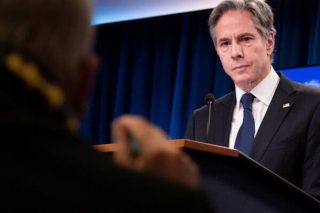
The U.S. responds to Russia’s demands
The U.S. and NATO gave formal responses yesterday to Russia’s demands that NATO pull back forces from Eastern Europe and bar Ukraine from ever joining the alliance. The U.S. response “sets out a serious diplomatic path forward should Russia choose it,” the secretary of state, Antony Blinken, said.
Russia has insisted for weeks that the U.S. provide written responses before the Kremlin decides on its next course of action and has asserted that it has no plans to invade Ukraine. Blinken said he expected to speak in the coming days with his Russian counterpart, Sergey Lavrov, once Russian officials are “ready to discuss next steps.”
The document has not been released publicly, but Blinken said it proposed “reciprocal transparency measures regarding force posture in Ukraine, as well as measures to increase confidence regarding military exercises and maneuvers in Europe” and nuclear arms control in Europe. The U.S. would not rule out future membership in NATO for Ukraine, he added.
Sanctions against Putin: President Biden said on Tuesday that economic sanctions against Russia could target Vladimir Putin, the Russian leader, personally, drawing a dismissive response from the Kremlin. Although Putin is believed to have amassed a great deal of personal wealth, it’s highly unlikely that any of it is in the U.S. A travel ban, experts said, would also have a limited effect.
Diplomacy: Envoys from France, Germany, Russia and Ukraine met in Paris on Wednesday, but expectations of a breakthrough were low.

The U.K.’s other health crisis
An enormous and growing backlog of patients in Britain’s free health service has led to delays or diversions in planned care, in part because of the pandemic — a largely unseen crisis within a crisis. The problems are likely to have profound consequences that will be felt for years.
In England, nearly six million procedures are currently delayed, up from 4.6 million before the pandemic, according to the N.H.S. — and most likely representing almost one-tenth of the population. Hundreds of thousands more people haven’t yet been referred for treatment, and many ailments have simply gone undiagnosed.
Experts say that severe staffing shortages this winter and the wildfire spread of the Omicron variant have almost certainly made the situation worse. Public health experts now worry that even if the pandemic eases and relieves some of the immediate burden, the pandemic and delayed care could do lasting harm to the health system, as well as to patients.
A troubling picture: A recent report from the parliamentary health committee revealed record waiting lists, high caseloads and severe staffing shortages. It warned that a major expansion of the labor force was needed in health care but that the government was not doing enough to recruit and train.
Related: The Times would like to speak to people in Britain who are facing tighter financial conditions as inflation reaches its highest point in 30 years. Get in touch with our team here.
Here are the latest updates and maps of the pandemic.
In other developments:
- Pfizer and BioNTech have begun a study of an Omicron-specific vaccine.
- European nations are diverging in their Omicron approaches. Austria and England are throwing out many rules. Poland and Germany are tightening them.
- As new cases climb in regions with low vaccination rates, the gap could set the stage for another dangerous variant, according to the W.H.O.

Biden’s Supreme Court pick
Justice Stephen Breyer, the senior member of the Supreme Court’s liberal wing, has announced his plans to retire, providing President Biden a chance to make good on his pledge to name a Black woman to the court. Democrats, who control the Senate by a narrow margin, may have to act quickly ahead of the midterms.
Judge Ketanji Brown Jackson of the powerful U.S. Court of Appeals for the District of Columbia Circuit, Justice Leondra Kruger of the California Supreme Court and Judge J. Michelle Childs, a Federal District Court judge, are among the leading candidates to succeed Breyer.
Senator Chuck Schumer, the majority leader, wants the entire process to take weeks, not months. The party could confirm a justice without G.O.P. support under rules that shield Supreme Court nominations from a filibuster but would have to hold its majority to do so.
Background: Breyer, 83, the oldest member of the court, was appointed in 1994 by President Bill Clinton. He leaves a legacy as a moderate liberal who rejected labels like “liberal.”
THE LATEST NEWS
Around the World

- A Kurdish-led militia that had been fighting Islamic State members for control of a Syrian prison regained full control yesterday, bringing to an end one of the most audacious attacks by Islamic State fighters in three years.
- The U.S. Coast Guard continued its search for 38 missing people whose boat capsized in the Florida Straits over the weekend, but the prospects of survival were fading.
- The Australian government bought the copyright to the Aboriginal flag, drawing criticism from some who said that ownership of the design belonged with Indigenous communities.
- A Palestinian American who died after he had been detained by Israeli soldiers had a heart attack as a result of injuries sustained while in custody, according to his autopsy report.
Other Big Stories

- Boeing reported a bruising $4.2 billion loss in the final three months of last year from prolonged delays in making and delivering its 787 Dreamliner jet.
- Older people who regularly breathe in even low levels of soot face a greater chance of dying early, according to a major study in the U.S.
- The Federal Reserve signaled it was on track to raise interest rates in March to reduce inflation.
Sport & Entertainment News
- Neil Young is removing his music from Spotify after the service refused to take down podcasts spreading Covid misinformation.
- Fans and tennis players are shifting the spotlight back onto Peng Shuai, months after the Chinese tennis star disappeared from public view after accusing a former vice premier of sexual assault.
- In women’s singles at the Australian Open, the unseeded Madison Keys will play Ashleigh Barty, the No. 1-ranked player, in the semifinals. The tennis world is changing, our columnist writes, and may soon be free of the shadow cast by the biggest stars.
A Morning Read

Five years ago, a chunk of Antarctic ice more than 100 miles long broke off from the Antarctic ice shelf. The resulting iceberg drifted north into warmer waters, where it has finally met its end near the island of South Georgia in the South Atlantic.
Because the ice was already floating, its melting did not contribute to sea-level rise — though scientists will be studying its effects on the ecosystem around the island for some time.
ARTS AND IDEAS

A rocket part is on track to hit the moon
A four-ton part of a SpaceX rocket that has been orbiting the Earth for years is expected to crash into the moon soon, potentially creating a 65-foot crater on impact. While numerous spacecraft sent to the moon have crashed there, this appears to be the first time that something from Earth not aimed at the moon will end up there.
The collision is predicted for 12:25 p.m. G.M.T. on March 4. While there is still some uncertainty regarding the exact time and place, the rocket piece is not going to miss the moon, said Bill Gray, developer of Project Pluto, a suite of software used to calculate the orbits of asteroids and comets.
The part, the upper stage of a SpaceX rocket, helped launch a deep-space observatory in February 2015. But because it needed all of its propellant to do so, the part ended up in a very high, elongated orbit around Earth. Its motion is now determined primarily by the gravitational pull of the Earth, the moon and the sun, with a nudge of pressure from sunlight.
Astronomers will get one more look next month before the rocket stage swings out beyond the moon and then heads in to hit its far side, out of sight of anyone from Earth. NASA’s Lunar Reconnaissance Orbiter will not be in a position to see the impact live, though it will later pass over the expected impact site and take photographs of the fresh crater.
PLAY, WATCH, EAT
What to Cook

These slick noodles tossed in a savory sauce are made by some Singaporeans to observe the beginning of the Lunar New Year celebrations.
What to Read
The nonfiction book “Eating to Extinction,” by the BBC food journalist Dan Saladino, is a celebration of rare foods and a warning about the future.
Tech Fix
Read our reviewer’s thoughts on the Oura Ring 3 — a tiny health-monitoring device that can track sleep and body temperature.
Now Time to Play
Here’s today’s Mini Crossword, and a clue: Work with needles and yarn (four letters).
And here is the Spelling Bee.
You can find all our puzzles here.
That’s it for today’s briefing. Thanks for joining me. — Natasha
P.S. Mohammed Hadi, who has worked in Dubai, Hong Kong, Singapore and New York, has been named as The Times’s new deputy business editor.
The latest episode of “The Daily” is about Covid and partisanship in the U.S.
FEATURED IMAGE: Secretary of State Antony Blinken. Credit…Pool photo by Brendan Smialowski
BY NATASHA FROST
THE NEW YORK TIMES




